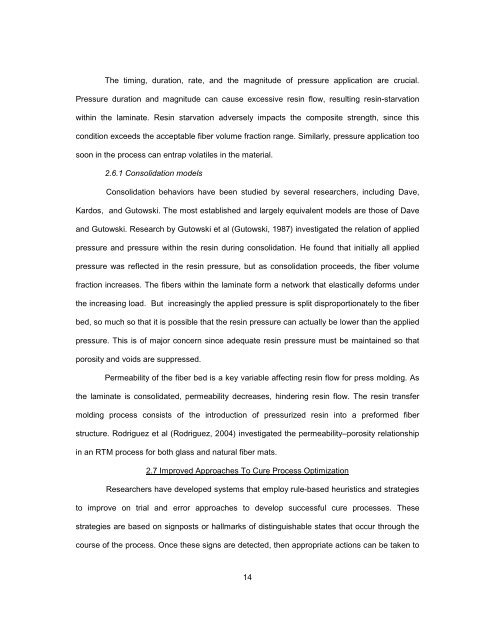TOOLED THICK COMPOSITES by ARVEN H. SAUNDERS III ...
TOOLED THICK COMPOSITES by ARVEN H. SAUNDERS III ...
TOOLED THICK COMPOSITES by ARVEN H. SAUNDERS III ...
Create successful ePaper yourself
Turn your PDF publications into a flip-book with our unique Google optimized e-Paper software.
The timing, duration, rate, and the magnitude of pressure application are crucial.<br />
Pressure duration and magnitude can cause excessive resin flow, resulting resin-starvation<br />
within the laminate. Resin starvation adversely impacts the composite strength, since this<br />
condition exceeds the acceptable fiber volume fraction range. Similarly, pressure application too<br />
soon in the process can entrap volatiles in the material.<br />
2.6.1 Consolidation models<br />
Consolidation behaviors have been studied <strong>by</strong> several researchers, including Dave,<br />
Kardos, and Gutowski. The most established and largely equivalent models are those of Dave<br />
and Gutowski. Research <strong>by</strong> Gutowski et al (Gutowski, 1987) investigated the relation of applied<br />
pressure and pressure within the resin during consolidation. He found that initially all applied<br />
pressure was reflected in the resin pressure, but as consolidation proceeds, the fiber volume<br />
fraction increases. The fibers within the laminate form a network that elastically deforms under<br />
the increasing load. But increasingly the applied pressure is split disproportionately to the fiber<br />
bed, so much so that it is possible that the resin pressure can actually be lower than the applied<br />
pressure. This is of major concern since adequate resin pressure must be maintained so that<br />
porosity and voids are suppressed.<br />
Permeability of the fiber bed is a key variable affecting resin flow for press molding. As<br />
the laminate is consolidated, permeability decreases, hindering resin flow. The resin transfer<br />
molding process consists of the introduction of pressurized resin into a preformed fiber<br />
structure. Rodriguez et al (Rodriguez, 2004) investigated the permeability–porosity relationship<br />
in an RTM process for both glass and natural fiber mats.<br />
2.7 Improved Approaches To Cure Process Optimization<br />
Researchers have developed systems that employ rule-based heuristics and strategies<br />
to improve on trial and error approaches to develop successful cure processes. These<br />
strategies are based on signposts or hallmarks of distinguishable states that occur through the<br />
course of the process. Once these signs are detected, then appropriate actions can be taken to<br />
14
















